We have long been conditioned to believe that women and men have fundamentally different expectations about leadership. Traditional gender stereotypes about men’s and women’s roles in the workplace and at home have helped to create overarching assumptions about what truly matters to each gender when it comes to careers, how to define great leadership, and expectations about diversity in the workplace.
We have also been quick to define entire generations by their stereotypical and cultural traits. Millennials are often characterized in two ways — either as an entitled and lazy generation or as idealistic and tech-savvy. The same can be said for baby boomers; competing narratives include the out-of-touch person who struggles to adapt in digital times or the loyal and hardworking executive.
How many of these gender and generational stereotypes are true? And does where we live in the world impact our views?
As part of Egon Zehnder’s Leaders & Daughters initiative, which convenes both experienced and emerging female leaders to explore the professional opportunities, challenges, successes and obstacles they face, we sought to find out just how differently genders, generations, and geographies define success and leadership. In January and February 2019, we surveyed more than 2,500 women and men with a range of leadership experience across seven countries — Australia, Brazil, China, Germany, India, the United Kingdom, and the United States. We asked them how they defined great leadership, the importance of a diverse organization, and how they prioritize and balance their professional and personal lives.
The findings challenged traditional assumptions by showing that when it comes to leadership, we are much more closely aligned than most would believe. Men and women often had similar views, with greater distinctions between generations, geographies and experience level. The generational findings also underscored the growing need for businesses to evolve workplace processes and policies to adapt to the changing professional and personal priorities of younger leaders.
Key Findings
-
Globally, the top three most desired characteristics in leaders were ethical (45%), strategic (45%), and humble (43%)
-
C-suite aspirations have nearly evened out between men and women, with 27 percent of women aspiring to reach the C-suite compared with 31 percent of men.
-
Career barriers and setbacks are a common obstacle in any leadership journey, irrespective of gender or generation; 90 percent of male and female millennials and 85 percent of male Gen Xers and 86 percent of female Gen Xers reported experiencing setbacks.
We hope these insights encourage people to seek common ground rather than amplify their differences and to find new ways to create stronger and more equitable organizations around the world. We will continue the conversation about this survey and other topics at more than 30 Leaders & Daughters events around the world in 2019
Defining Leadership
One of the most unexpected results of our survey was the fact that women and men had much more similar perspectives on leadership than we had expected. Yet we saw distinct differences between generations.
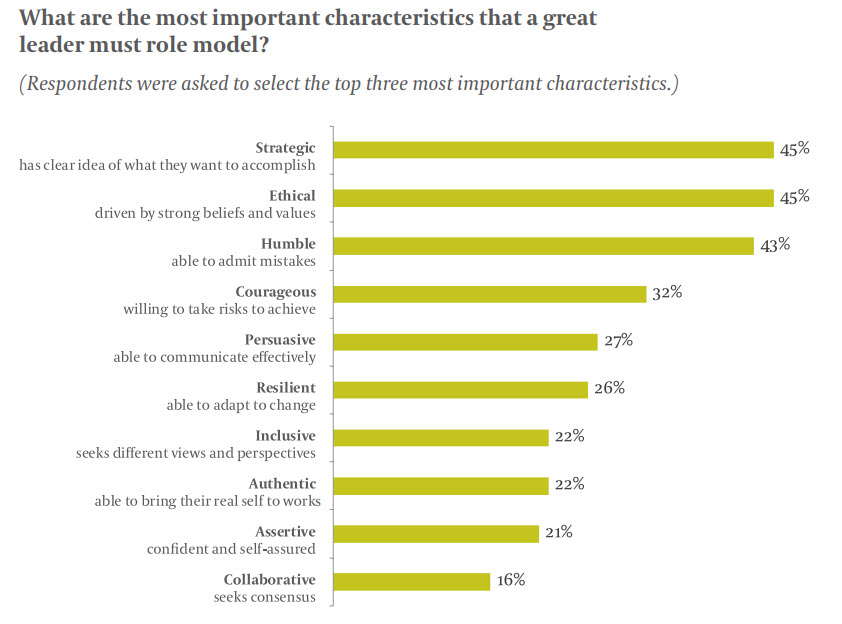
Across genders, geographies, and generations, respondents wanted ethical leaders who are driven by strong beliefs and values (45%), strategic leaders who have a clear idea of what they want to accomplish and how to do it (45%), and humble leaders who are able to admit when they’ve made a mistake (43%).
Younger generations expect their leaders to be humble. Millennials rated humility much higher than any other generation (48%), compared with the global average (43%). Male millennials, in particular, were more likely to say humility was important (55%), compared with male boomers (32%). Boomers were more likely to prize resilience as a key leadership quality (35%), compared with millennials (21%).
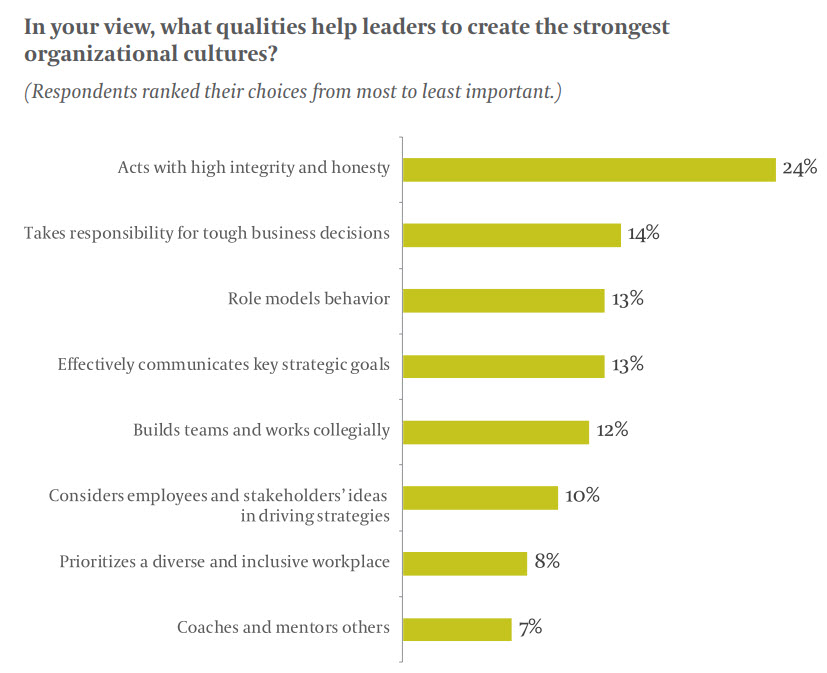
While Millennials highly valued humility, they were less concerned with integrity and honesty, which was surprising given public discourse about compromised data, highprofile figures caught in lies, and business leaders committing fraud. Honest leadership was less important to those under 45 years old — only 21 percent selected this as the top leadership quality — compared to those over 45, 30 percent of whom said this was the most important quality.
Millennials were much more likely than other generations to say their leaders always exhibit the key leadership qualities they expected (38%), while only 22 percent of boomers and 26 percent of Gen Xers concurred. Male boomers were the least likely to agree their leaders demonstrated these positive qualities; 25 percent said their leadership never or only occasionally demonstrated these important qualities.
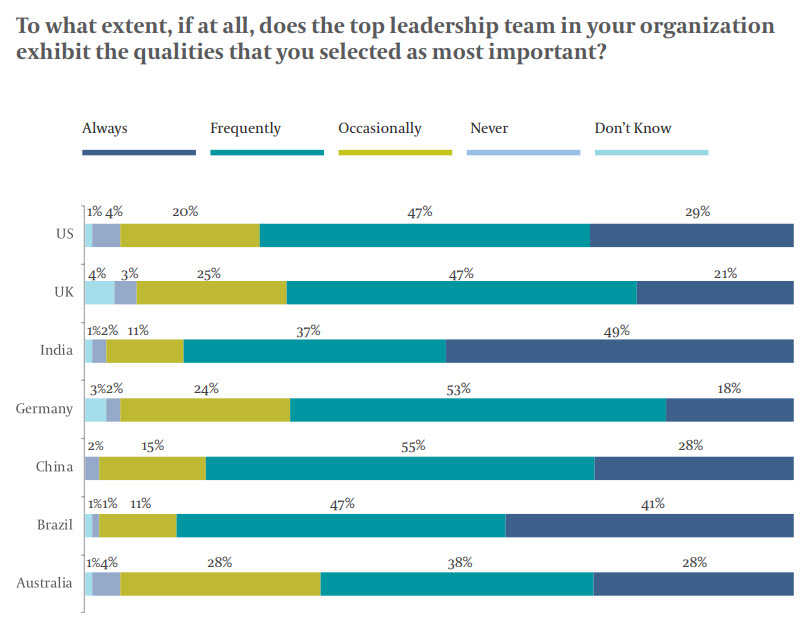
Respondents in developing countries were more likely to agree that leaders always or frequently exhibited the qualities that they found most important compared with those in developed countries.
Defining Diversity at Work
Our survey found that a diverse workplace was more important to younger generations. We asked respondents to rank the significance of a diverse workplace on a fourpoint scale, from very important to unimportant. Millennials (65%) and Gen Xers (61%) said it was very important, compared with boomers (51%). Male boomers in particular were not as focused on the value of diversity in the workplace, with nearly a quarter (23%) saying it was not important to them. Geographically, a diverse and inclusive workplace was more important to respondents in China (78 percent said it was very important) compared to those in Germany (44 percent said it was very important).
When it came to equal opportunities at work, a majority (61%) believed there were equal opportunities for all, though female Gen Xers were the least likely to believe that they had equal access to equal opportunities (57% said they did) compared to female millennials (63% said they did). This underscores the need for today’s leaders to ensure there is a pipeline for men and women to advance within organizations.
A high number of respondents also believed their organizations valued diversity of thought, with 69 percent overall saying their companies genuinely believed in different ways of thinking and unique approaches to solving problems. There were no significant differences between genders, but younger generations tended to believe this slightly more than older ones, with 71 percent of those under 35 agreeing, compared with 68 percent of those 55 and older.
Defining Career Success
While there were some differences between men and women in how they defined their highest career goals, there were far greater differences between generations, geographies, and job titles — as has been the predominant trend in this study.
First, an important finding is that C-suite aspirations have nearly evened out between men and women, with 27 percent of women aspiring to reach the C-suite compared with 31 percent of men. It’s worth noting, however, that women have a more difficult path ahead. Egon Zehnder’s 2018 Global Board Diversity Tracker shows women make up just 3.7 percent of CEOs and 12.2 percent of CFOs globally. Millennials were the most aspirational group, with 33 percent hoping to reach the C-suite compared with 13 percent of boomers (the global average was 29 percent).
Brazil had the highest number of respondents seeking a top organizational role (41%), followed by India (40%), and China (32%). The United States (25%), the United Kingdom (21%), and Germany (9%) had the fewest respondents aspiring to reach the C-suite. These statistics echo our 2017 study in which Brazil, China, and India again took the top spots for C-suite aspirations.
Some interesting results emerge when looking at statistics by organizational level. Just over half of current senior leaders aim to reach the C-suite (51%), while the numbers for junior leaders (14%) and mid-level leaders (20%) are significantly lower, a surprising result for people so early in their careers. Perhaps some of these leaders cannot see a clear path to advancement or they simply do not want to be at the top levels of their organization. Regardless of motivation — or the lack thereof — this waning ambition could lead to heightened employee turnover and a dearth of leaders with institutional knowledge of their organizations.
Another interesting finding was the fact that respondents who had children (33%) were more likely to have C-suite ambitions than those without children (22%).
Chief Motivations
We also asked our respondents to rank their motivations for working. Boomers were the most concerned with being able to provide for themselves and their families — 45 percent ranked this as their number one motivator. Male boomers were particularly motivated by this factor — 51 percent ranked it number one—compared with 34 percent of female boomers. It was significantly less important to millennials (24%), perhaps because they may not have families to think about yet, and somewhat less important to Gen Xers (32%)
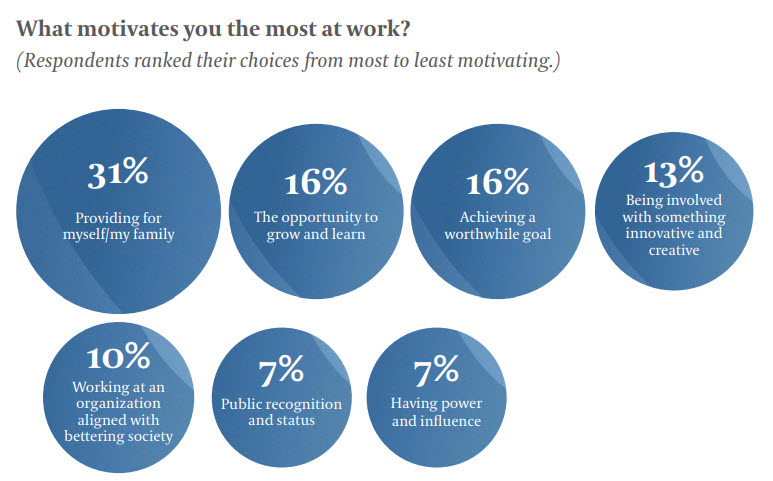
On the whole, having power and influence and public recognition and status were the least motivating factors, with only 7 percent of global respondents ranking these as top motivators. Millennials were slightly more motivated by power and influence and public recognition, with 9 percent ranking power and influence their top motivator and 9 percent selecting public recognition as their number-one influence. Only 5 percent of boomers selected power and influence first and 2 percent named public recognition their main goal. These statistics may not tell the full story, as survey respondents sometimes resist selecting responses that may appear to be less socially desirable even if they do believe they are important.
Barriers to Success
The vast majority of respondents (86%) have experienced some type of barrier during their career journeys. While barriers are often assumed to be experienced more acutely by women, 67 percent of male boomers said they experienced barriers during the course of their careers (72 percent of female boomers said the same). Perhaps because there’s more awareness about career barriers than there used to be, younger generations were more likely to have experienced them — 90 percent of male and female millennials and 85 percent of male Gen Xers and 86 percent of female Gen Xers reported such setbacks.
The barriers manifest differently based on generation, geographic location, and job title. Significantly, 38 percent of C-suiters believed conscious or unconscious bias from peers has been a barrier. The highest reports of bias came from China and India (40%), with the lowest in the United Kingdom (26%). Generationally, millennials were more likely to say conscious or unconscious bias has been a barrier (36%), compared with boomers (26%). Gen X was in the middle, with 32 percent naming this as a barrier.
Millennials also showed a strong desire for mentoring and sponsorship. When asked about factors that have limited their opportunities at work, more than twice as many millennials (35%) as boomers (17%) claimed that a lack of mentors or sponsors has been a barrier to their own career success.
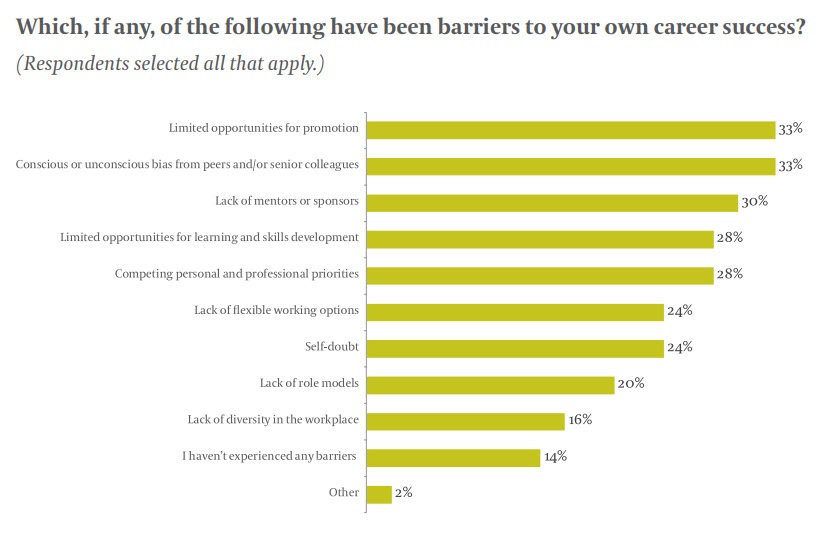
Balancing Act
Yet for all of the struggles with bias, the news was better when we asked about balancing work and life. Most respondents (82%) said they always or frequently were able to strike the right balance between personal and professional responsibilities. Millennials were more likely to say their work and life demands are in balance (87%) than Gen Xers (80%) or boomers (78%). This sentiment may fuel younger generations’ more inclusive approach to blending their personal and professional lives, which allows them greater flexibility in pursuing what matters to them.
Our Take
While our survey shows that women and men are pretty evenly aligned in their workplace expectations, the findings underscore the need for change in accommodating a rising generation of leaders. The following are steps today’s leaders can take to improve workplaces for the next generation.
Break down barriers.
Unconscious and conscious bias and limited opportunities for promotion are preventing organizations from recognizing and developing future top talent. Consider instituting anti-bias training for all employees and work to develop a level of transparency that allows employees to see a variety of career paths within an organization.
Try to understand—and reverse—declining ambitions.
The data from our survey showed that only 14 percent of junior leaders and 20 percent of mid-level leaders were seeking a C-suite role. What factors are inspiring that type of response? As senior leaders recognize potential in employees, candid conversations about future ambitions and goals may uncover barriers or concerns that are holding them back.
Don’t make assumptions based on gender.
As we saw throughout this study, change is happening and power is shifting. Women and men are equally seeking leadership roles, people with families are seeking professional fulfilment in addition to personal fulfilment, and career barriers are impacting nearly everyone. We all must be more attuned to the shifting priorities of younger leaders and seek to understand the unique work/life expectations among generations and geographies.
To further explore these findings, visit Egon Zehnder's Data Visualizer.





